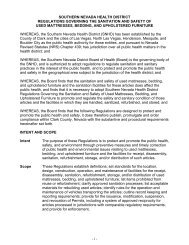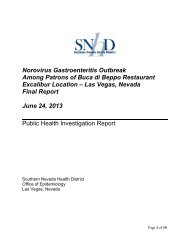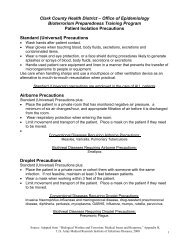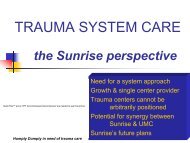Current Trauma Status Report - Southern Nevada Health District
Current Trauma Status Report - Southern Nevada Health District
Current Trauma Status Report - Southern Nevada Health District
You also want an ePaper? Increase the reach of your titles
YUMPU automatically turns print PDFs into web optimized ePapers that Google loves.
• Information Management<br />
• Finances<br />
• Research<br />
• Technology<br />
• Disaster Preparedness and Response - Conventional & Unconventional<br />
National Overview<br />
It has only been in the past 20 years that trauma systems have existed at all. The need for improved<br />
emergency treatment was reported in research as early as the late 1950s. 3 Additionally, the benefits of<br />
immediate treatment of injuries had become apparent from the experience of treating injured soldiers<br />
during the Korean and Vietnam wars. However, the first major step toward the development of trauma<br />
systems came in 1966, when the National Academy of Sciences and National Research Council<br />
published a white paper entitled Accidental Death and Disability: The Neglected Disease of Modern<br />
Society. 4 This report identified significant deficiencies in the provision of care for injured patients in<br />
this country, and it was instrumental in spurring the development of systems of trauma care. That<br />
same year, the 1966 Highway Safety Act was enacted, reinforcing the states' authority to set standards,<br />
regulate EMS and implement programs designed to reduce injury.<br />
In the early planning years urban hospitals affiliated with medical schools had the staffing resources to<br />
provide timely treatment of injuries, but others did not. Illinois was a leader with the establishment of<br />
designated trauma centers in both urban and rural areas. In the following years, Maryland established<br />
the Maryland Institute for Emergency Medical Services Systems (MIEMSS) and the first statewide<br />
trauma system.<br />
In 1973, the Emergency Medical Services Act (P.L. 93-154) was enacted to stimulate the development<br />
of regional EMS systems. This Act contributed significantly to the growth of EMS infrastructure.<br />
Fifteen program components were recognized as essential elements of an EMS system, including the<br />
clear identification for the need of trauma systems. In 1981 this program ended and was folded into<br />
the Preventive <strong>Health</strong> and Human Services (PHHS) Block Grant Program. Studies done in the late<br />
1970s revealed high rates of preventable injury deaths. In 1983 West, Cales, et al, conducted a<br />
comparison of preventable death rates pre- and post-trauma system implementation and found a<br />
reduction from 73 percent to 9 percent. 5 Numerous additional studies by others have supported these<br />
conclusions.<br />
In 1985, the National Research Council and Library of Medicine published another white paper entitled<br />
Injury in America—A Continuing Public <strong>Health</strong> Problem. 6 The report concluded that a great deal still<br />
needed to be done for injury control. The report advocated increased resources for injury prevention<br />
and led to the creation of an injury prevention center under the Centers for Disease Control (CDC).<br />
Additional Injury Control Research Centers have since been established throughout the country.<br />
After much debate and planning, The <strong>Trauma</strong> Care Systems Planning and Development Act of 1990<br />
(P.L.101-590) was passed. The Act encourages state governments to develop, implement and improve<br />
regional trauma systems. The primary focus of the Act is the development by each state of a trauma<br />
care plan that takes into account national standards for the designation of trauma centers and for<br />
3 Root GT, Christensen BH: Early surgical treatment of abdominal injuries in the traffic victim. Surg Gynecol Obstet 105:264, 1957; Van Wagoner FH:<br />
Died in a hospital—A three year study of deaths following trauma. J <strong>Trauma</strong> 1:401, 1961.<br />
4 National Academy of Sciences and National Research Council, Accidental Death and Disability: The Neglected Disease of Modern Society.<br />
Washington, DC, 1966.<br />
5 West JG, Cales RH, Gazzaniga AB: Impact of regionalization—The Orange County experience. Arch Surg 118:740, 1983.<br />
6 National Research Council and Library of Medicine. Injury in America—A Continuing Public <strong>Health</strong> Problem. Washington, DC, National Academy<br />
Press, 1985.<br />
Page 14
















